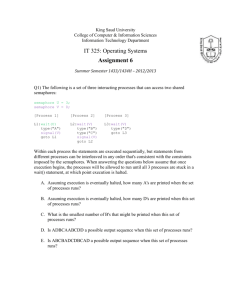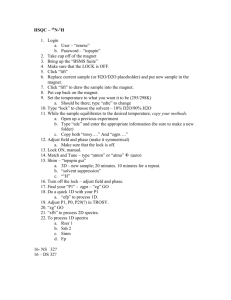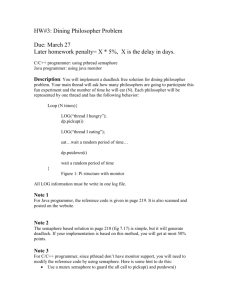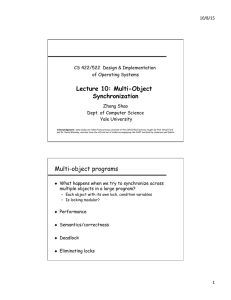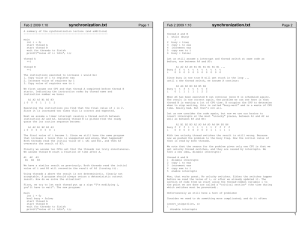exam-1-full
advertisement
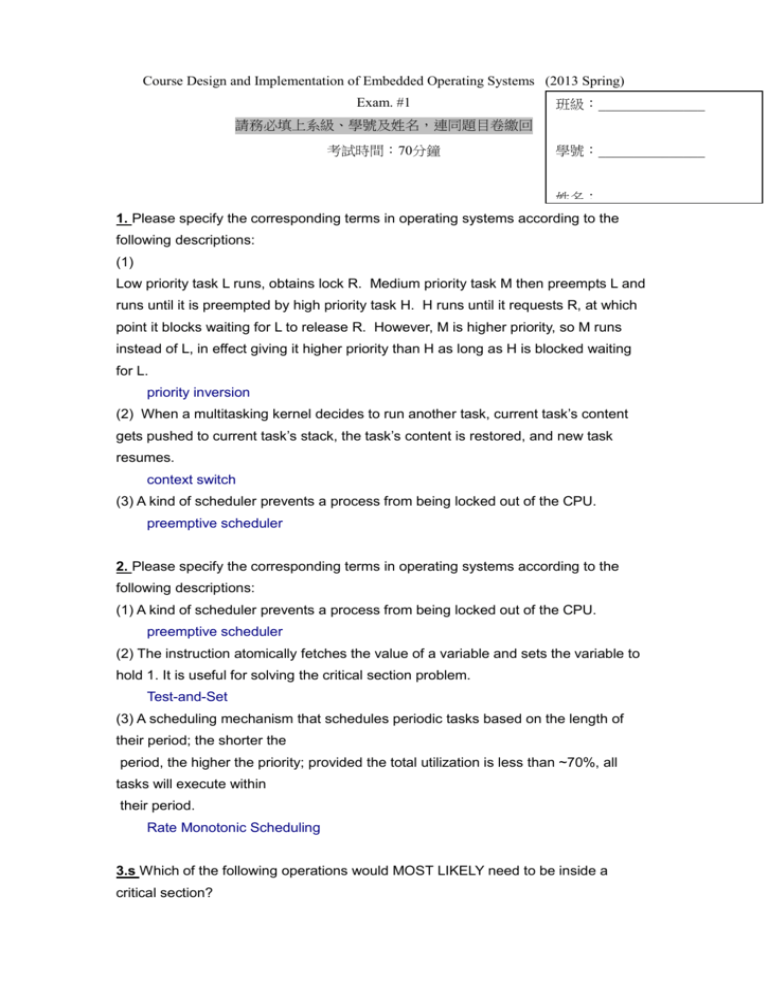
Course Design and Implementation of Embedded Operating Systems (2013 Spring)
Exam. #1
班級:_______________
請務必填上系級、學號及姓名,連同題目卷繳回
考試時間:70分鐘
學號:_______________
姓名:_______________
1. Please specify the corresponding terms in operating systems according to the
following descriptions:
(1)
Low priority task L runs, obtains lock R. Medium priority task M then preempts L and
runs until it is preempted by high priority task H. H runs until it requests R, at which
point it blocks waiting for L to release R. However, M is higher priority, so M runs
instead of L, in effect giving it higher priority than H as long as H is blocked waiting
for L.
priority inversion
(2) When a multitasking kernel decides to run another task, current task’s content
gets pushed to current task’s stack, the task’s content is restored, and new task
resumes.
context switch
(3) A kind of scheduler prevents a process from being locked out of the CPU.
preemptive scheduler
2. Please specify the corresponding terms in operating systems according to the
following descriptions:
(1) A kind of scheduler prevents a process from being locked out of the CPU.
preemptive scheduler
(2) The instruction atomically fetches the value of a variable and sets the variable to
hold 1. It is useful for solving the critical section problem.
Test-and-Set
(3) A scheduling mechanism that schedules periodic tasks based on the length of
their period; the shorter the
period, the higher the priority; provided the total utilization is less than ~70%, all
tasks will execute within
their period.
Rate Monotonic Scheduling
3.s Which of the following operations would MOST LIKELY need to be inside a
critical section?
a. Fetch the value of a nonshared variables.
b. Fetch the value of a shared variable.
c. Reduce the value of a nonshared variable by 1.
d. Reduce the value of a shared variable by 1.
<d>
4.s Consider the 2-process solution to the critical section problem (‘i’
refers to the current process and ‘j’ is the other one):
repeat
while turn <> i do no-op;
<critical section>
turn:=j;
<remainder section>
until false;
This solution does NOT satisfy
a. Mutual Exclusion
b. Progress
c. Bounded Waiting
d. Both (b) and (c)
e. None of the above
<b>
Note: Bounded waiting is inherently satisfied in strict alteration solution because the
code
forces each process to be only once in critical region, and after that another process
must access the critical region. Hence, each process waits only one cycle to get in
the
critical region. What is NOT satisfied is progress since one process could block in
remainder section and the progress of the overall solution would be hindered.
5.s Consider the 2-process solution to the critical section (‘i’ refers to the
current process and ‘j’ is the other one):
repeat
flag[i]:=true;
turn := j;
while (flag[j] and turn ==j) do no-op;
<critical section>
flag[i] := false;
<remainder section>
until false;
This solution does NOT satisfy:
a. Mutual Exclusion
b. Progress
c. Bounded Wait
d. Both (b) and (c)
e. None of the above
<e>
Note: The code represents the Peterson solution.
6.s Assume names Down()=P(), Up()=V(), and given:
binary semaphore m;
semaphore f; /* counting semaphore*/
semaphore d; /* counting semaphore*/
m=1; f=n; d=0;
Producer(i):
Loop:
...................../* (1)
...................../* (2)
Deposit new data x into buffer
V(m);
...................../* (3)
EndLoop
Consumer(i):
Loop:
P(d);
P(m);
Consume next data y from buffer
................../* (4)
................../* (5)
EndLoop
Complete the pseudo-code solution to the bounded buffer problem:
a. P(f)=>(1), P(m)=>(2), V(f)=>(3), V(m)=>(4), V(d)=>(5)
b. P(f)=>(1), P(m)=>(2), V(d)=>(3), V(m)=>(4), V(f)=>(5)
c. P(d)=>(1), P(m)=>(2), V(d)=>(3), V(m)=>(4), V(d)=>(5)
d. P(d)=>(1), P(m)=>(2), V(f)=>(3), V(m)=>(4), V(d)=>(5)
<b>
Note: This is the producer/consumer problem with bounded buffer solved with
counting semaphores (using m for mutex, f for empty and d for full semaphores).
7. What is the
difference between Rate
Monotonic
and Earliest-Deadline-Firs Scheduling?
RM schedules
task based on
priori/es that are based on task periods. RM is a static priority-based scheduling
scheme. EDF schedules task based on earlies deadlines. EDF is a dynamic prioritybased scheduling scheme.
8.s A synchronization algorithm is wait-free if, when it is used, no thread
a. ever needs to wait for another thread to do anything, under any
circumstances
b. needs to wait for any other thread, as long as no thread spends long inside
critical sections.
c. needs to wait for any other thread that does not want to enter a critical section
d. can be made to wait to enter a critical section while more than some bounded
number of other threads enter the critical section ahead of it.
<a>
9. In systems that use strict priority-based scheduling, synchronization techniques
for shared resources may lead to priority inversion. Assume three threads A, B, and
C with
reasonable values for respective priorities.
Let A’s priority be 1, B’s 2, and C’s 3.
Max priority = 3
The original sequence causes priority inversion:
A acquires lock L
C tries to acquire L
C blocks on L
B preempts A (B’s 2 > A’s 1)
C cannot make progress due to B. Although C’s 3 > B’s 2
How can we avoid it. Describe the sequence.
A acquires lock, get priority 1+3=4
C tries to acquire L
C blocks on L
B cannot preempt A (B’s 2 < A’s 4)
A releases L
C acquires L
10. In Consider the following code. What is the outcome of this program, and why?
int bigBuffer[100] = { /* 100 random numbers */ };
int sum;
void addMe(int start)
{
int c;
for (c=start; c< start+50; c++)
sum += bigBuffer[c];
}
main()
{
thread_create(A, addMe, 0 /*start parameter */);
thread_create(B, addMe, 50);
/* wait for threads to finish
*/
print sum;
}
There is a race for shared variable sum.
The result will be some
unpredictable value depending on how the two threads are scheduled.
11. Consider the task set shown in Table 1.
There are three resources:A, B and C. The time required to access each resource
is A: 2 ms; B: 3 ms; and C: 1 ms. The tasks access the resources once on each
release according to Table 2. You may assume that there are no nested resource
accesses (that is, each task can only access one resource at a time).
Task
Computation Time
Period
Deadline
T1
7
40
20
T2
6
90
40
T3
7
50
30
T4
8
25
12
Table 1: Task characteristics (milliseconds)
Task
A
B
T1
*
*
T2
*
T3
*
*
T4
*
*
C
*
*
Task 2: Resource requirements
Using Deadline Monotonic Priority Assignment, assign priorities to T1, T2, T3, and
T4. Use larger numbers to represent higher priorities.
Task
Computation Time Period
Deadline
Priority
T1
7
40
20
3
T2
6
90
40
1
T3
7
50
30
2
T4
8
25
12
4
12. A well in a desert village is only big enough to allow 5 villagers at a time to draw
water from it. If more than 5 villagers tried to get water simultaneously, a brawl would
occur and everyone would suffer.
Having recently learned that Computers can help solve problems, the village elders
have hired you to help them. You decide to model the villager’s problem using a
computer program. Assuming that each villager is represented by a thread, the
following code would be run by each
thread.
villager_thread()
{
while (1)
{
waitInLine();
// get water
returnHome();
// use water
}
}
Using FreeRTOS-style semaphores write the C code for the waitInLine()
and returnHome() functions to avoid a fight at the well.
(a)
// insert variable declaration(s)
// + initialization here
xSemaphoreHandle accessToWell = NULL;
xSemaphoreCreate(&accessToWell, 5);
(b)
void waitInLine() {
while (!xSemaphoreTake(&accessToWell, MAX_DELAY);
}
(c)
void returnHome() {
xSemaphoreGive(&accessToWell);
}
13. Implemented wait()/exit() using a semaphore
that is used to signal a child process’s completion to its parent, as follows:
process_wait(tid_t ctid)
{
lock_acquire(process_list);
find child c with tid == ctid in process_list
sema_down(&c->exit_semaphore); // wait for child
lock_release(process_list);
}
process_exit()
{
lock_acquire(process_list);
find own position o in process list
sema_up(&o->exit_semaphore); // signal parent
lock_release(process_list);
}
However, they found that their Pintos kernel hung for several tests, but not
for all tests.
(a) Explain what sequence of events would lead to their kernel
deadlocking and why.
If parent calls wait() before the child exits, the parent will acquire the
process_list lock, and then block on sema_down (as the child has not yet
exited). Now, when the child exits, process_exit() blocks on
lock_acquire. This cyclic dependency leads to deadlock.
(b) For this problem, consider locks only. One of the necessary
conditions for a deadlock to occur is that there must be a cycle in the waitfor graph. To avoid such cycles, suppose you assigned a unique integer to
each lock upon creation.
The unique identifier could be used to enforce a strict order in which threads
acquire multiple locks. This can be done by forcing the threads to acquire locks in
a specific order (e.g. ascending order of integer IDs) only. If lock A has an
identifier lower than lock B, lock_acquire() will allow threads to first get A and
then B, but not vice versa. This prevents deadlocks due to different threads
acquiring same lock in different order.
14. Synchronization mechanisms are typically implemented using atomic operations provided by the underling architecture; e.g., test-and-set or compare-and-swap.
Consider
an operation: fetch-and-increment (fai), which behaves as an atomic counter that is
sampled,
then incremented. It can also be initialized to 0. In other words, if you create an fai
variable
using fai a; you can issue two atomic operations, namely int j = a++; and a=0;. Your
task
is to use fai to implement a solution to the critical section problem. You need not
guarantee
fairness among multiple processes. Assume no fai variable can overflow.
fai inside = 0; // inside is an atomic counter
int a;
repeat
a = inside++;
until (a == 0)
/* Critical Section */
inside = 0;





